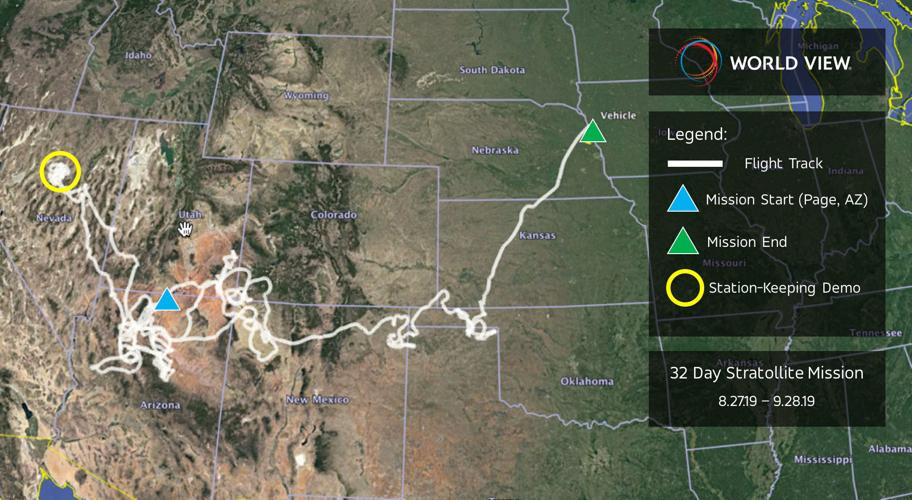Tucson-based World View Enterprises says it reached a new milestone in its quest to perfect stratospheric balloon vehicles that can stay aloft under navigational control for weeks or months at a time.
The company says one of its Stratollite vehicles stayed aloft for more than 32 days and traveled more than 11,200 kilometers, or nearly 7,000 miles, over 10 states before a controlled landing last weekend.
Previously, the longest Stratollite flight, in June, lasted 16 days.
World View’s flight operations team landed the Stratollite on command at a predetermined landing zone in Iowa on Saturday.
The system was recovered and will be refurbished for reuse on future missions, the company said.
World View says its proprietary navigational systems allow it to keep the balloon vehicles essentially hovering over the same area, approximating geostationary orbit for Earth imaging and sensing applications at a fraction of the cost of orbiting satellites.
The company said the latest mission moves World View closer to scaled commercial operations, which target commercial and government customers around the world.
“This is another encouraging milestone for the team and our customers that confirms we are on the right track,” said Ryan Hartman, World View president and CEO since replacing co-founder Jane Poynter in February.
Some other key accomplishments of the latest mission, according to the company:
- Flew a total of 32 days, 5 hours and 14 minutes, completely controlled from World View’s mission control center in Tucson with more than 1,000 trajectory control maneuvers;
- Met a mission objective of achieving four continuous days of “station keeping” with an average distance of 20 kilometers from a predetermined target location, followed by an intentional navigation to a second station-keeping target location 1,230 kilometers away;
- Achieved two and a half days of continuous station keeping at the second station at an average distance of 40 kilometers from the target location;
- Averaged an altitude of 19.5 kilometers — about 12 miles or almost 64,000 feet — during both station-keeping exercises.
World View said it will continue to increase the pace of its flight operations as the company moves toward the near-term commercial production and use of the Stratollite.
The company said it plans to launch multiple missions “in the very near future,” focused on demonstrating optical imaging and synthetic aperture radar sensing systems while further enhancing station-keeping and navigational performance.
Raytheon, Rheinmetall team up
Raytheon and Germany’s Rheinmetall Defence recently submitted a joint bid to compete for the U.S. Army’s “Optionally Manned Fighting Vehicle” program — a replacement for the venerable Bradley Fighting Vehicle — based on Rheinmetall’s Lynx infantry fighting vehicle.
At least one other industry team, led by General Dynamics Land Systems, has submitted a formal bid to develop and produce the OMFV, which must be able to operate fully manned or as a remotely operated weapons platform.
Raytheon technology earmarked for the Lynx includes the company’s advanced weapons, such as the wireless TOW missile, its Active Protection System to counter grenades and anti-tank missiles, third-generation thermal sights, the Coyote unmanned aircraft system and cyberprotection.
Rheinmetall unveiled the Lynx in 2016 and has offered it to Australia and the Czech Republic for their future fighting vehicle programs.
The joint effort, originally announced a year ago, is headed on the Raytheon side by the land-warfare systems division of Tucson-based Raytheon Missile Systems.
Over the weekend, Raytheon and Rheinmetall announced that they had created a formal joint venture to compete for the program and had selected Textron Systems to build the Lynx chassis in the U.S.
Textron Systems plans to perform the work at its manufacturing facility near New Orleans in Slidell, Louisiana, Raytheon said.
UA tech bus tour on tap
Tech Parks Arizona has organized an event to tour a bus full of people around some of the University of Arizona’s most fertile technology breeding grounds on Oct. 16, as part of the TenWest Impact Festival.
“Driving Innovation Forward — A Roving Brunch Bus Tour” will depart from the Tucson Convention Center at 7:30 a.m. and return at 1:30 p.m., with stops including the UA Tech Park on South Rita Road, the park’s Solar Zone, the nascent Arizona Forge incubator at Roy Place, the UA Tech Park at The Bridges, the UA Health Sciences Innovation Building and the Bio5 Institute.
Seating for the tour is limited, and the tour costs $35 as an add-on fee to the TenWest Festival (with a discounted $25 fee available through Tech Parks Arizona).
For registration or questions, send an email by Oct. 10 to: communications@uatechpark.org.





